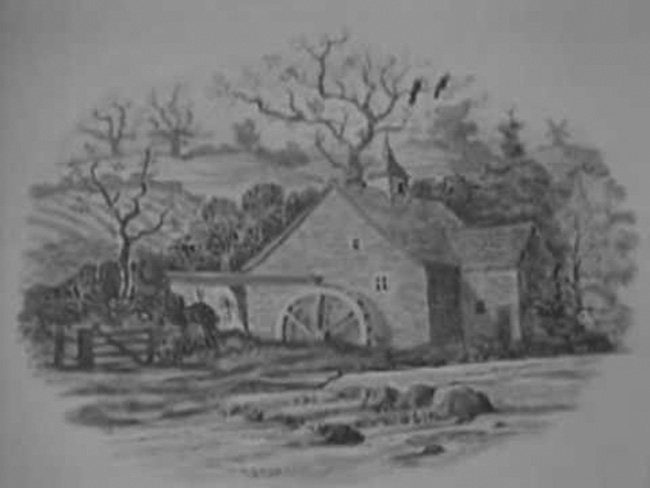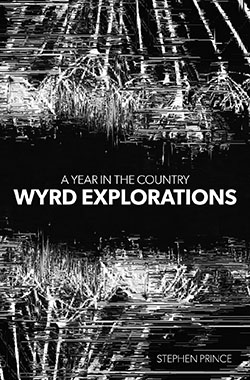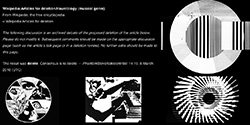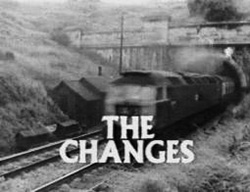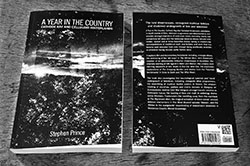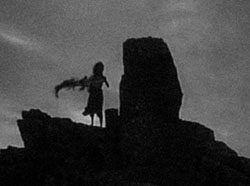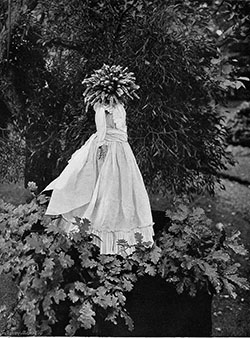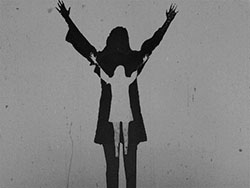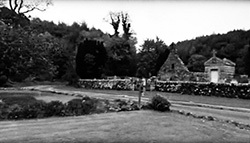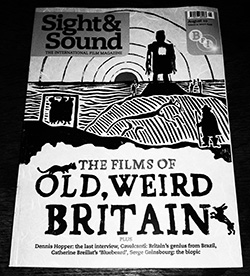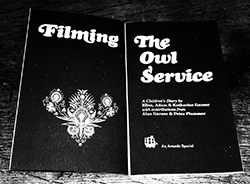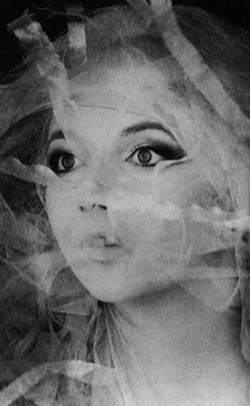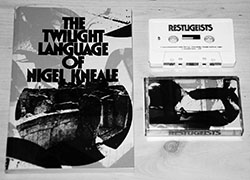
Bagpuss is a children’s television animated series made by Oliver Postgate and Peter Firmin’s Smallfilms and was first broadcast on British television in 1974. It creates a dreamlike atmosphere of an imagined lost Arcadian idyll and is set in some unnamed past era, probably early twentieth century, and based around a shop owned by a young girl called Emily, in which nothing was sold but rather she displayed lost and broken things in order that their owners would hopefully discover and collect them.
Each episode begins with a sepia-tinted sequence that explains about Emily and the shop and the things in it, and during which Emily brings a new “thing” to the shop and says a magical evocation to wake up her much-loved cloth cat Bagpuss, who lives in the shop, after which she leaves (although she isn’t pictured doing so).
Bagpuss and his toy animal, doll and ornament friends who also live in the shop then wake up and come to life, the world changes from sepia to colour, and they discuss what the new object is. One of them would then tell a story related to the object, often accompanied by a song which would generally draw from British traditional and folk music. After this, the mice in the shop would mend the object while in squeaky voices they would sing of their work to a tune adapted from the traditional song “Summer is Icumen in”.
There would be much banter and bickering between the characters (with pompous academic and wooden woodpecker Professor Yaffle notably often finding fault with the playful mice of the shop), but by the end of each episode peace would be restored and the newly-mended object would be placed in the shop window, hopefully to be seen and claimed by its owner. Bagpuss would then yawn and fall asleep, with both him and his friends becoming inanimate objects again and their world fading once more to sepia.
Writing this synopsis caused me to remember just how odd, fantastical and unexplained the world and premise of Bagpusswas. How did Emily know that Bagpuss and his friends could be brought to life? Where did she discover the magical evocation that brings them to life? And was the wider “real” world actually sepia coloured, only turning into colour when Bagpuss woke up? Also, curiously, nobody apart from Emily ever seems to see or discover the shop when the toys have sprung to life and their world has become subtly unreally full of vivid colour.
All I can say is that in the world that Bagpuss creates it all makes seamless sense and rational questions do not intrude.
Bagpuss is possibly the most fondly remembered and iconic example of Peter Firmin and Oliver Postgate’s Smallfilms work, and as I have written previously “it contains a sweetness, a uniqueness and gentle melancholia that arguably has never been repeated or equalled”2 and conjures up a sense of a warmly enchanting never-never land.
The music from Bagpuss was created by John Faulkner and Sandra Kerr, and in 1999 was released as a 21 track CD album by Smallfolk/Fellside under the title Bagpuss: The Songs & Music. Then in 2018 it was given something of a spruce up via a remastered and extended album called The Music from Bagpuss, which was released on CD and vinyl by Earth Recordings.
I first became aware of The Music of Bagpuss album via a review of it by Helen Skinner in issue 2 of Actual Size magazine published in 2018:
“Some 44 years ago, an audience of young children was introduced to and fell under the spell of the titular saggy old cloth cat in a charming, gentle, handmade stop motion animation. If you need any kind of confirmation of the magic of this show, you only need to listen to the plucked strings of first track ‘Opening’ on this newly remastered soundtrack album and you’ll be whisked back to that comfy, sepia-tinted world… That’s not to say only fans of the show can enjoy this album; the music here is a beautiful patchwork of British folk which stands up on its own as a really rewarding listen, much like The Wicker Man soundtrack before it… The 32 tracks which make up the main body of the album are – like all good folk music – a patchwork of traditional pieces, half-remembered tunes and pure improvisation.”
The Music from Bagpuss was released by Earth Recordings in four different editions, including a CD in one of the hardback book-style sleeves with inner pages that have been used more frequently over the last decade or so, including Earth Recordings’ reissue of Anne Briggs’ 1971 folk album The Time Has Come;4 various of their solo releases by Bert Jansch (who was one of the founders in 1967 of the renowned folk-jazz band Pentangle); and their release of the DVD and soundtrack CD set of the documentary The Ballad of Shirley Collins (2017), which focuses on the work and life of English folk singer Shirley Collins, who played a significant role in the English folk revival of the 1960s and 1970s and whose work has been an influence and reference point for contemporary wyrd culture and related folk music.
These “bookbacks” are a rather handsome way of presenting CDs and DVDs and it would be nice to see them used by more labels, as there is something about them which makes releases feel more precious or thought about in some way, particularly in contrast to, say, a standard plastic DVD case without even a booklet, as is often the case. Anyway, I digress…
There are 49 tracks in total on The Music from Bagpuss, including a number of outtakes and alternate versions, and there are also accompanying sleeve notes on Bagpuss from the illustrator Daniel Postgate, who is Bagpuss’ co-creator Oliver Postgate’s son, writer and comedian Stewart Lee, singer and songwriter Frances McKee who performed with the Scottish indie/alternative rock band The Vaselines, Sarah Martin of the band Belle & Sebastian who have been stalwarts of independent music for a number of decades and the co-founder of archival record label Finders Keepers Records Andy Votel.5
It is always something of a treat to be able to revisit the folk and traditional music-orientated soundtrack for Bagpuss, and to have it so well presented, restored and comprehensively collected as on this release is icing on the cake. Just writing about it now makes me want to go and relisten to “The Miller’s Song”, which as I have previously written is:
“…a lilting, life-affirming and yet also curiously quietly melancholic song about the cyclical nature of farming and rural life, the growing of crops and the passage of those crops to the mill and eventually via the baker to become loaves of bread…” (Quoted from A Year In The Country: Wandering Through Spectral Fields, 2018.)
As is in part mentioned above, the style of the series suggested the early twentieth century Edwardian Era, but although it had a notable vintage quality, as also mentioned previously, it more seemed to exist in a sepia-toned time all of its own. The sense of a time unto itself is also present in the artwork for The Music from Bagpuss album, for which the characters from Bagpuss have been reinterpreted by Hannah Alice in a contemporary illustration/ graphic design manner. These bring to mind retro-styled but contemporarily produced children’s book illustrations, with the uncluttered minimal vintage tinged illustrations adding to the atemporal nature of the world of Bagpuss.
When I first watched Bagpuss in the 1970s it felt like being offered a brief view or portal into a magical otherly world, and looking back now it may have been a very early childhood influence and discovery of more left-of-centre or even subtly experimental forms of pastoralism or “wyrd” rural and folk culture which would quietly sow the seeds for A Year In The Country.
Similar themes are discussed in Andy Votel’s sleeve notes for The Music from Bagpuss, where he writes that for “those fifteen minutes that followed shortly after lunchtime your TV set became a secret shop window”. He also writes of how he has wondered if his childhood watching and being entranced by Bagpuss and Emily’s shop of lost curiosities may have been one of the things that fuelled his future fascination with visiting dusty second- hand shops and hoping to find and then release “lost” music and objects.
He also goes on to talk of how the music in Bagpuss, and in particular the dulcimer twangs that accompany Bagpuss coming to life and the mice’s squeaky re-worded version of “Summer is Icumen In”, may well have subliminally stoked his obsession with The Wicker Man (1973), which featured a version of the song. Related to which, Finders Keepers Records, which as mentioned previously Andy Votel co-founded, released the compilation album Willow’s Songs in 2009, which collected traditional British folk songs that inspired The Wicker Man soundtrack, and also reissued David Pinner’s novel Ritual that was first published in 1967, which was one of the inspirations for The Wicker Man.
Both Sarah Martin and Frances McKee talk in their sleeve notes for The Music from Bagpuss about how “The Mouse Mill” episode is their favourite, something which they seem to share with a number of people. In that episode, the mice in Emily’s shop appear to be able to make an endless supply of chocolate biscuits using “breadcrumbs and butter beans”, which to young viewers with a sweet tooth and limited access to money may well seem like a magical nirvana-like ability. Sadly, it is all just a ruse and sleight of hand as the mice are merely rotating the same one biscuit over and over again…
Perhaps the lack of money being necessary at Emily’s shop is part of the magic of Bagpuss that has made it so enduringly entrancing for younger viewers with only pocket-money to spend and/or who rely on grown up’s generosity and money in order to buy toys, sweets and so on; as Andy Votel says in his sleeve notes for The Music from Bagpuss, the shop was a place where “the toys themselves were the shopkeepers and mum’s purse wasn’t needed.”
Acting as something of a companion piece to The Music from Bagpuss is Jonny Trunk and Richard Embray’s The Art of Smallfilms book, released by Four Corners Books in 2014, which collects objects, artwork, stills and so on from the Smallfilms archive:
“It’s a book full of pipe cleaners, cotton wool, wire and pingpong balls and it provides a behind the scenes or glimpse behind the curtain view of [the television series] Bagpuss, Clangers, Ivor the Engine, Noggin The Nog and so on.” (Quoted from The Art of Smallfilm’s cover text.)
Interestingly, despite it offering an at-times near forensic study of the television series created by Smallfilms and “a glimpse behind the curtain”, the book does not break the spell of their work and the worlds it created. This may in part be due to a number of the items featured, such as for example the adjustable skeletons of the figures used to animate characters in the series, often having an intriguing folk art-esque quality and their own particular charm to them, which merely adds to the spell and worlds they create rather than puncturing them.
In the Introduction to The Art of Smallfilms, the above- mentioned comedian and writer Stewart Lee talks of how the book presents the archive of Smallfilms “as one would a collection of artifacts in an exhibition detailing some much-admired 20th century art movement, like Fluxus or Dada”.
It does indeed present objects from the archive in a museum like and, as suggested above, an at times almost forensic manner, but it also brings to mind a rather poshly-produced scrapbook.
That sense of scrapbooking, of the importance and sheer enjoyment in childhood that tracking down and collecting things could bring is something that may be considered to be present in a number of the archival books which Jonny Trunk has worked on, and also his record label Trunk Records’ release of archival film soundtracks etc7 (and also the archival releases of the earlier mentioned Finders Keepers Records).
The books Jonny Trunk has worked on have often focused on what was originally considered ephemeral or purely utilitarian, whether the archiving of one man’s collection of old sweet wrappers, tickets, badges etc in Wrappers Delight (2020), library music cover art in The Music Library (2005, 2016), flexi disc art in Wobbly Sounds (2019) or the 1960s and 1970s packaging design work of a supermarket’s design studio in Own Label (2011, 2019), amongst other books and subjects.
These books can be seen as a form of elevating and focusing on such work in a way that, consciously or not, acknowledges that for much of the population the culture they connected with and/or came into contact with on a regular basis in previous decades, was more likely to arrive via television sets, record players, the aisles of the pick’n’mix-like high street store Woolworths and so on, rather than art galleries and museums. They are not necessarily dismissive of or in conflict with more fine art and highbrow culture orientated gallery and museum-based archiving and exhibiting, but, as with The Music from Bagpuss, rather make the case for also valuing, archiving and studying creative work from other sometimes more overlooked, populist and/or utilitarian areas of previous decades’ culture.





